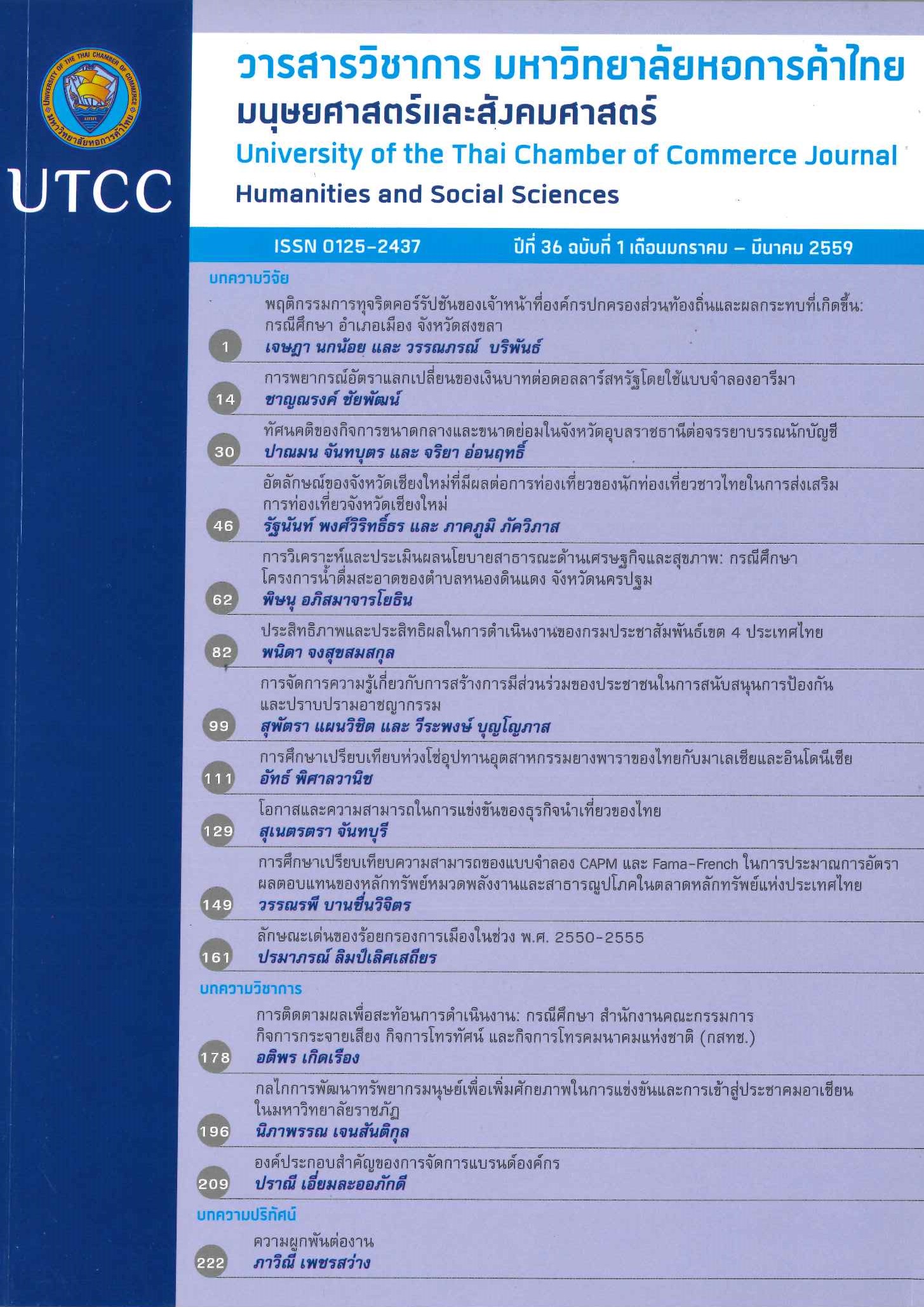A Comparative Study of the Rubber Industry Supply Chain in Thailand Malaysia and Indonesia
Main Article Content
Abstract
This research aims to analyze and compare the supply chain of the rubber industry in Indonesia, Malaysia and Thailand. The methods of this study include collecting primary and secondary data, rubber-industry related documentaries and research reviews, in-depth interviews with entrepreneurs, the private sector and government agencies in Indonesia, Malaysia and Thailand. This study found that the rubber-industry supply chains of these three countries are quite similar, except for the production proportion of upstream, midstream and downstream products. In Indonesia and Thailand, products gained from the supply chain are sufficient for domestic demands and exports, although limited midstream and downstream products need to be imported, however they are minimal when compared with domestic production. Malaysia mostly imports midstream and downstream products due to inadequate domestic production to meet the demands within the country. Malaysia imports rubber and its products mostly from Thailand, followed by Vietnam and Indonesia. The study found that Indonesia, Malaysia and Thailand are not only competitors in the global market, but also are important partners in connecting and sharing products and raw materials with each other in both midstream and downstream industries.
Article Details
ลิขสิทธิ์ของบทความ
ผลงานที่ได้รับการตีพิมพ์ถือเป็นลิขสิทธิ์ของมหาวิทยาลัยหอการค้าไทย ห้ามมิให้นำเนื้อหา ทัศนะ หรือข้อคิดเห็นใด ๆ ของผลงานไปทำซ้ำ ดัดแปลง หรือเผยแพร่ ไม่ว่าทั้งหมดหรือบางส่วนโดยไม่ได้รับอนุญาตเป็นลายลักษณ์อักษรจากมหาวิทยาลัยหอการค้าไทยก่อน
References
Department of Agriculture, Rubber Research Institute of Thailand. 2015. Thailand Rubber Statistics [Online]. Available: https://www.rubberthai.com/statistic/stat_index.htm. (in Thai).
กรมวิชาการเกษตร. สถาบันวิจัยยาง. 2558. สถิติยางไทย [ออนไลน์]. เข้าถึงจาก: https://www.rubberthai.com/statistic/stat_index.htm.
Department of Statistics Malaysia. 2014. Annual Rubber Statistics 2014. Putrajaya, Malaysia: Department of Statistics Malaysia.
Global Trade Atlas. 2015, April 20. Data Statistics. [Online]. Available: https://www.gtis.com/gta.
International Rubber Study Group. 2015. IRSG Rubber Statistical Bulletin. 69, 7-9: 2-3, 6-54.
LMC International. 2014. Outlook for Natural and Synthetic Rubbers 2014 Report. Kuala Lumpur, Malaysia : LMC.
Malaysian Rubber Board. 2013. Natural Rubber Statistics 2013 [Online]. Available: https://www.lgm.gov.my/nrstat/nrstats.pdf.
. 2014. Natural Rubber Statistics 2014 [Online]. Available: https://www.lgm.gov.my/nrstat/nrstats.pdf.
. 2015. Natural Rubber Market Review. January 2015.
. 2015. Natural Rubber Market Review. February 2015.
Pisanwanich, Aat. 2013. “The Study of the Potential of Thai Industrial Goods under BIMSTEC Agreement.” University of Thai Chamber of Commerce Journal 33, 2: 125-148. (in Thai).
อัทธ์ พิศาลวานิช. 2556. “การศึกษาศักยภาพสินค้าอุตสาหกรรมของไทยภายใต้กรอบความร่วมมือ BIMSTEC”. วารสารวิชาการ มหาวิทยาลัยหอการค้าไทย 33, 2: 125-148.
Pisanwanich, Aat. 2015. “Thai Analysis of the Effects of the Malaysian plan to become the World’s Rubber Center on Thai Rubber Industry”. University of Thai Chamber of Commerce Journal 35, 1: 144-161. (in Thai).
อัทธ์ พิศาลวานิช. 2558. “การวิเคราะห์ผลกระทบต่ออุตสาหกรรมยางพาราของไทยจากแผนการเป็นศูนย์กลางยางพาราโลกของมาเลเซีย. วารสารวิชาการ มหาวิทยาลัยหอการค้าไทย 35, 1: 144-146.
Statistics and Planning Department Rubber Board. 2015. “The Trend.” Rubber Statistical News. 73, 8: 1 - 4.
Thailand Ministry of Industry, The Office of Industrial Economics . 2009. Strategy for Industrial Cooperation Development under the BIMSTEC: the Bay of Bengal Initiative for Multi-Sectoral Technical and Economic Cooperation. Bangkok: The Office of Industrial Economics. (in Thai).
กระทรวงอุตสาหกรรม. สำนักงานเศรษฐกิจอุตสาหกรรม. 2552. โครงการพัฒนาความร่วมมือด้านอุตสาหกรรมกับประเทศเพื่อนบ้าน (ยุทธศาสตร์การพัฒนาความร่วมมือด้านอุตสาหกรรม ภายใต้กรอบ BIMSTEC: Bay of Bengal Initiative for Multi-Sectoral Technical and Economic Cooperation). กรุงเทพมหานคร: สำนักงานเศรษฐกิจอุตสาหกรรม.
Thailand Ministry of Industry, The Office of Industrial Economics. 2013. Industrial Cooperation Development with Neighboring Countries Project (Industrial Cooperation Development Strategy of IMT-GT). Bangkok: The Office of Industrial Economics. (in Thai).
กระทรวงอุตสาหกรรม. สำนักงานเศรษฐกิจอุตสาหกรรม. 2556. โครงการพัฒนาความร่วมมือด้านอุตสาหกรรมกับประเทศเพื่อนบ้าน (ยุทธศาสตร์การพัฒนาความร่วมมือ ด้านอุตสาหกรรม ภายใต้กรอบโครงการ พัฒนาเขตเศรษฐกิจสามฝ่าย อินโดนีเซีย-มาเลเซีย-ไทย: IMT-GT). กรุงเทพมหานคร: สำนักงานเศรษฐกิจอุตสาหกรรม.
The Thailand Research Fund. 2013. Thai Analysis of the Effects of the Malaysian plan to become the World’s Rubber Center on Thai Rubber Industry and agreements under the ASEAN Economic Community (AEC) Project. Bangkok: The Thailand Research Fund. (in Thai).
สำนักงานกองทุนสนับสนุนการวิจัย. 2556. โครงการการวิเคราะห์ผลกระทบต่ออุตสาหกรรมยางพาราของไทยจากเป้าหมายการเป็นศูนย์กลางยางพาราโลกของมาเลเซีย และข้อตกลงภายใต้ประชาคมเศรษฐกิจอาเซียน. กรุงเทพมหานคร: สำนักงานกองทุนสนับสนุนการวิจัย


